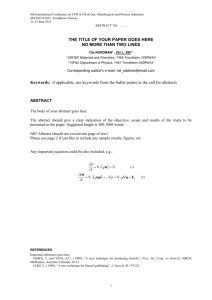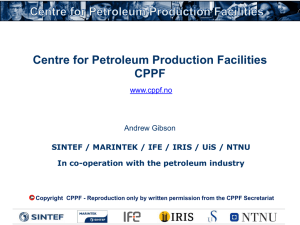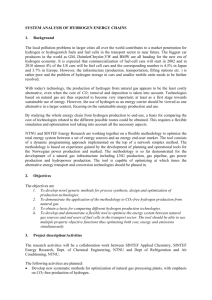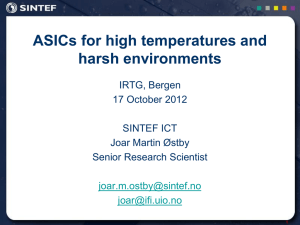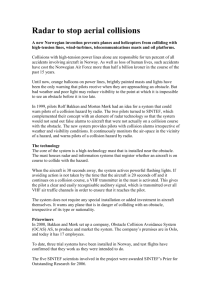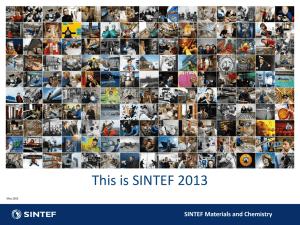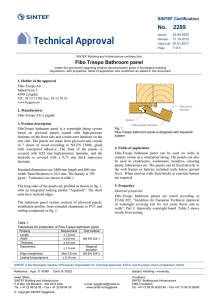What is the 'knowledge economy'? Knowledge
advertisement
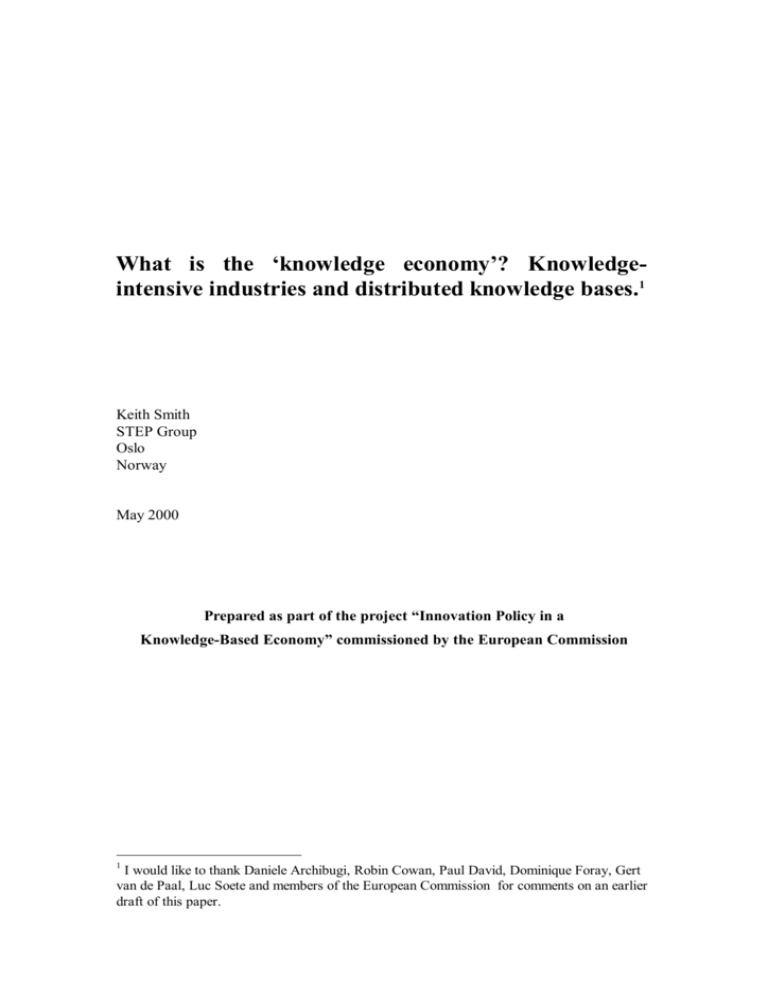
What is the ‘knowledge economy’? Knowledgeintensive industries and distributed knowledge bases.1 Keith Smith STEP Group Oslo Norway May 2000 Prepared as part of the project “Innovation Policy in a Knowledge-Based Economy” commissioned by the European Commission 1 I would like to thank Daniele Archibugi, Robin Cowan, Paul David, Dominique Foray, Gert van de Paal, Luc Soete and members of the European Commission for comments on an earlier draft of this paper. Introduction: technology and competence Public policies for science, technology and innovation have always been aimed primarily at creating and diffusing knowledge. In recent years such policies have attracted increasing attention as a result of claims that knowledge-intensive industries are now at the core of growth, and that we are now entering a new type of knowledge-driven economy or even a completely new form of ‘knowledge society’. What does it mean to speak of a ‘knowledge-intensive’ industry or a ‘knowledgebased’ economy, however? These terms are often used in a superficial and uncritical way, and there is a real need to consider whether they are anything more than slogans. The objectives of this paper are firstly to assess some of the issues involved in the concept of a knowledge economy or learning economy, and to criticise the idea that the knowledge economy should be identified with high-technology industries (as conventionally defined). Against this background I describe some empirical dimensions of knowledge creation in Europe, and then turn to concepts and a methodology for mapping the knowledge base of an economic activity. The paper proposes the concept of a ‘distributed knowledge base’ for industries, and argues that the term ‘knowledge economy’ is only meaningful if we see it in terms of widelyspread knowledge intensity across economic activities, including so-called ‘low technology’ sectors. The knowledge economy There are many who argue that we are moving towards a new ‘knowledge-based economy’ or ‘knowledge society’, in which the role and significance of knowledge as an input to economic processes has fundamentally changed. In some cases it is argued that this rests on advances in information technology that are leading to a ‘paradigm shift’. The idea here seems to be that there are basic changes in economic functioning, and changes in the economic rules of the game, for both business and policymakers. Proponents of such views can be found in business, where the 'new paradigm' has been held to justify previously high levels of stock prices in ICT and Internet-related companies, as well as in policy-making, and in innovation analysis. 1 But what does it mean to speak of the ’knowledge economy’? At the outset, it must be said that there is no coherent definition, let alone theoretical concept, of this term: it is at best a widely-used metaphor, rather than a clear concept. The OECD has spoken of knowledge based economies in very general terms, as meaning “those which are directly based on the production, distribution and use of knowledge and information”.2 This definition is a good example of the problems of the term, for it seems to cover everything and nothing: all economies are in some way based on knowledge, but it is hard to think that any are directly based on knowledge, if that means the production and distribution of knowledge and information products. Beyond such general definitions there seem to be four basic views about the changed significance of knowledge: Firstly, there are those who believe that knowledge is quantitatively and in some sense qualitatively more important than before as an input. Peter Drucker, for example, suggests that 'Knowledge is now becoming the one factor of production, sidelining both capital and labour.'3 Along the same lines, the OECD has suggested that “…the role of knowledge (as compared with natural resources, physical capital and low-skill labour) has taken on greater importance. Although the pace may differ, all OECD economies are moving towards a knowledge-based economy”.4 Secondly, there is the idea that knowledge is in some way more important as a product than it has been hitherto - that we are seeing the rise of new forms of activity based on the trading of knowledge products. Thirdly, there is the view that codified knowledge (as opposed to tacit, personincorporated skills) is in some ways more significant as a component of economicallyrelevant knowledge bases. Thus Abramowitz and David argue that 'Perhaps the single 2 OECD, The Knowledge Based Economy, OECD/GD (96) 102, p.7 P. Drucker, ’From capitalism to knowledge society’ in D. Neef (ed.) The Knowledge Economy, (Woburn MA: Butterworth) 1998, p.15 4 OECD, The Knowledge-Based Economy: A Set of Facts and Figures, (OECD:Paris), 1999p.7. 3 2 most salient characteristic of recent economic growth has been the secularly rising reliance on codified knowledge as a basis for the organisation and conduct of economic activities…'.5 Finally, there are those who argue that the knowledge economy rests on technological changes in ICT, since innovation in computing and communications changes both physical constraints and costs in the collection and dissemination of information. So for some, the rise of ICT technologies and the complex of ICT industries is coterminous with the move to a knowledge society. Lundvall and Foray argue a more sophisticated view: 'Even if we should not take the ICT revolution as synonymous with the advent of the knowledge-based economy, both phenomena are strongly interrelated … the ICT system gives the knowledge-based economy a new and different technological base which radically changes the conditions for the production and distribution of knowledge as well as its coupling to the production system'. 6 How valid are these claims? It is hard both to distinguish among and to assess these ideas, either in terms of the role of knowledge in general, or in trends. For example, when we speak of a 'knowledge economy' we should bear in mind that all economic activity rests on knowledge, not only in our society but in all forms of human society. Paleolithic society was by any standards knowledge-based, and paleoanthropologists have demonstrated the existence of apparently well-formed bodies of knowledge with respect to animal behaviour, pyrotechnology, materials, mining, symbolic communication, the aerodynamic properties of weapons, cosmology and even medicine.7 Tribal peoples of our own time, such as the Bushmen of southern Africa or Australian aborigines, clearly possess sophisticated environmental and technical 5 M. Abramowitz and P. David, ’Technological change and the rise of intangible investments: the US economy’s growth path in the twentieth cenutury’ in OECD, Employment and Growth in the Knowledge-Based Economy (OECD: Paris), 1996, p.35 6 B-Å. Lundvall and D. Foray, 'The knowledge-based economy: from the economics of knowledge to the learning economy', OECD Employment and Growth in the KnowledgeBased Economy (OECD: Paris), 1996, p.14 7 For an overview of the archeological evidence of these technical accomplishments, and debates of its interpretations, see R. Rudgely, The Lost Civilisations of the Stone Age (New York: The Free Press), 1999. 3 knowledges.8 Looking to the recent past, the industrial economy of the nineteenth century was intensively knowledge-based, and it might be that many claims about the current ’knowledge economy’ could plausibly have been made a hundred years ago. Indeed Karl Marx claimed exactly that, arguing that a distinguishing feature of midnineteenth century capitalism was ’the conscious application of science’, and he explicitly treated separation of the conception and execution of tasks (that is, separation out of a knowledge function) as central to mechanisation. The argument that ‘knowledge is sidelining capital’ rests on the implicit idea that we can separate knowledge accumulation (and hence technological advance) from capital accumulation. While this idea is central to neoclassical production theory (it is the entire basis of the residual concept), it is highly questionable: knowledge cannot be incorporated into production except via investment, and the function of investment is often to implement new knowledge in production technology. There is no real separability. At a more aggregate level, the claim that ‘knowledge is sidelining capital’ cannot be sustained by empirical data. The OECD itself has produced series comparing investment in physical capital and investment in ‘knowledge’ (meaning public spending on education, total R&D and software). For the OECD as a whole, physical investment is about two and a half times greater than ‘knowledge’ investment as a percentage of GDP. In terms of growth rates, ‘knowledge’ investment is growing faster than physical investment in the USA, the Nordic countries and France. But physical capital investment is growing faster than ‘knowledge’ investment in Italy, Japan, Australia, Belgium, Germany, Austria, the Netherlands and the UK.9 The data does not therefore support any general claim that knowledge is increasing in importance aggregate production input. 8 ‘The monotonous western desert of long, low sandhills and gravel knolls lacked real seasons, making food unpredictable. Yet …the aborigines considered food less a problem than the terrifying lack of water. [The anthropologist Dr Richard] Gould, who happened to visit in the last months of a record drought, summed up this habitat as the world's "most unreliable and impoverished". Yet these Australians lived a healthy, contented and fulfilled life. They survived not so much through great physical endurance as through knowledge - their "cognitive map" of where to find food and, especially, water.’ M. Symons, 'Aboriginal Life', in C. Spencer and C. Clifton (eds) The Faber Book of Food, (London: Faber) 1996, pp. 70-71 9 See ‘Investment in tangibles and knowledge’, The Knowledge-Based Economy: A Set of Facts and Figures, OECD:Paris, 1999, p.9 4 The notion that knowledge is more important as a product usually rests on claims about the growing significance of knowledge-intensive business services. Despite some rather tricky statistical issues in defining these services, and in determining whether some services are an independent source of growth or primarily an effect of vertical disintegration in manufacturing, the evidence is strong that these sectors are growing (certainly growing more rapidly than high technology sectors in manufacturing), and playing an important role in inter-industry diffusion of knowledge. There has been a strong growth in Europe and the U.S. in the share of business services in inter-industrial trade.10 So there is good evidence that this is an area of real change; but the importance lies not in such services as an autonomous source of growth, but as a connecting process within the innovation system. This should direct our attention to economy-wide aspects of the use of knowledge. In terms of the use of codified knowledge, there is no doubt that both the extension of formal education, and the uses of codified results of science are rising. In general the only employment categories that are rising across OECD economies are those for people with higher education. In terms of codified science, perhaps the clearest indicator is the growth of citations to basic science in patents, a very sharp upward trend in recent years. However each of these trends requires careful interpretation – it is not clear either that they are new, or that they represent some new role for knowledge. Educational qualifications, for example, are often argued to represtent a signalling mechanism in the labour market, rather than some kind of knowledge input. Then there is the role of ICT. Knowledge refers to understanding and competence. It is clearly true that ICT makes major changes to our ability to handle data and information, but these are not themselves knowledge, and ICT does not necessarily create knowledge or even extend knowledge. It is an information resource, and a major question which follows is, how does an information resource relate to the production of knowledge? Lundvall and Foray are almost certainly right in saying that 5 ICT plays a new role in knowledge production and distribution, but this is a reorganisation of the technical and financial terms on which a resource (information) is available. It does not in itself justify talking about a new mode of economic or social functioning. There is an empirical issue here as well, of course. If knowledge is a crucial input, and ICT is basic to its production, then seeing that the ICT revolution has been under way for at least twenty-five years there ought to be some robust relationship between ICT production, ICT investment and the growth of output and productivity. A series of studies have failed to demonstrate such a link.11 The claims sketched above rest on analytical and empirical support that varies from sophisticated (but questionable)) to nonexistent, and it seems that we are some way from really being able to assess the strength of these different perspectives, or whether they really add up to implying a new type of economy. But this does not alter the fact that knowledge has been and continues to be a core foundation of the economic process. It is important therefore for policymakers to have an understanding of the relevance, structure and characteristics of knowledge across industries. These critical considerations nevertheless provide a problem for those who wish to speak of a new knowledge-based society. It is certainly true that knowledge accumulates over time, and that it changes the quality and quantity of output very significantly. But does this obvious point mean we are entering some new form of society which is qualitatively different in terms of the use of knowledge? The burden of proof here is on those who claim that the ‘knowledge society’ exists and is above all qualitatively new as a form of society; the conclusion suggested here is that none of those who have used the term have succeeded in conceptualising the phenomenon, 10 For an excellent systematic overview of the issues and evidence related to knowledge-intensive business services, see Johan Hauknes, Services in innovation – innovation in services. SI4S final report, STEP Group Report S1 1998, especially pp.29-48. 11 This literature on the impacts of ICT begins in the late 1980s, and is continuing. For an early example, see Martin Neil Bailey and Robert Gordon, ’The productivity slowdown, measurement issues and the explosion of computer power’, Brookings Papers on Economic Activity, 2, 1988, pp. 347 - 423; probably the latest contributions are D. Jorgensen and K.Stiroh, ’Information technology and growth’, American Economic Review, May 1999, pp. 109-116. For a comprehensive discussion see Daniel Sichel, The Computer Revolution. An Economic Perspective (Washington: Brookings Institution), 1997 6 let alone demonstrating that something new has happened. This does not mean that thinking in terms of knowledge is unimportant or irrelevant. It simply means that more care should be used in formulating and using the term. Knowledge-intensive industries? Before moving to a discussion of knowledge in industry, it is necessary to make a diversion via the concept of ‘high-technology’. In much policy analysis it is common to use the terms 'high-technology' or 'knowledge intensive industries' in a somewhat loose way, as though in fact they are both meaningful and interchangeable terms. But we ought to remember that the term ‘high technology’ is a rather recent invention, and that its meaning is far from clear. The standard approach in this area rests on a classification developed by the OECD in the mid-1980s. 12 The OECD distinguished between industries in terms of R&D intensities, with those (such as ICT or pharmaceuticals) spending more than 4% of turnover being classified as high-technology, those spending between 1% and 4% of turnover (such as vehicles or chemicals) being classified as medium-tech, and those spending less than 1% (such as textiles or food) as 'low tech'. In fact the OECD discussion of this classification was rather careful, and offered many qualifications. Chief among these is the point that direct R&D is but one indicator of knowledge content, and that technology intensity is not mapped solely by R&D. Unfortunately the qualifications were forgotten in practice, and this classification has taken on a life of its own; it is widely used, both in policy circles and in the press, as a basis for talking about knowledge-intensive as opposed to traditional or non-knowledgeintensive industries. This is a serious problem, since the OECD classification as it is used rests on only one indicator, namely intramural R&D. This is open to two important objections. First, it is only one measure of knowledge-creating activities. Second, it ignores the fact that 12 See OECD, OECD Science and Technology Indicators, No 2: R&D, Innovation and Competitiveness, (OECD:Paris), pp. 58-61. 7 the knowledge which is relevant to an industry may be distributed across many sectors or agents: thus a low-R&D industry may well be an major user of knowledge generated elsewhere. This issue will be discussed in a more empirical manner below. Even so it is not clear that this classification helps us even in a limited analysis of trends. One great problem is that in fact the high-tech sector thus defined is small, and there are therefore some difficulties in arguing that it is driving the growth process. In the OECD, for example, the USA has the largest share of high-tech in manufacturing, but this is only 15.8% of manufacturing output, which in turn is only 18.5% of GDP. So the high-tech sector is less than 3% of GDP. It is hard to see how either the direct or indirect impacts of such a small component of output could have a significant effect on overall economic growth. Most discussions of the role of high-tech are conducted in terms of share analyses, or even share-of-share analyses. This can easily confuse matters. In virtually all of the OECD economies the share of high-tech in total manufacturing has risen in the longer term, and this is widely used as an argument for the claim that such industries are central to growth. However this is complicated by the fact that that the share of manufacturing in total output has been in long-term decline. So between 1980 and 1995, the high-tech share of US manufacturing increased from 10.5% to 15.8%, while the share of manufacturing in GNP decreased from 21.6% to 18.5%; what this actually implies is that the share of high-tech manufacturing in total GNP rose over fifteen years by well under one percentage point.13 It is not uncommon to see quite sweeping claims made for the high-tech sector which are not supported by widely available evidence. For example, OECD’s ‘Knowledge based Economy’ claims that ‘Output and employment are expanding fastest in high-technology industries, such as computers, electronics and aerospace’.14 But the OECD’s own ‘Scoreboard of Indicators’ actually shows long-term negative growth rates of employment in high-tech manufacturing in eleven of fifteen OECD countries for which data are presented (including the USA, where high-tech employment declined at a faster rate than manufacturing employment generally). 13 All of the data in the foregoing paragraph is drawn from OECD, Science, Technology and Industry, Scoreboard of Indicators, 1997. 14 Op. Cit., p.9 8 Such problems have not led to any questioning of the high-tech/low-tech distinction. On the contrary, it has recently been extended, to divide the medium-tech category into medium-high and medium-low technology industries. Such classificatory manoeuvres cannot, however, alter the fundamental limitations of the category, and ought to cause us to question the identification of knowledge intensive and high-tech industries. Firms and industry expenditures on knowledge creation: the empirical evidence It is mistaken to identify knowledge creation with intramural R&D, partly for conceptual and partly for practical reasons. Conceptually, R&D data tends to rest on a view of innovation that overemphasizes the discovery of new scientific or technical principles as the point of departure of an innovation process (an approach sometimes called the ’linear model’ of innovation). It sees innovation as a set of development stages originating in research, and it is this prior significance of research that licences using R&D as a key knowledge indicator. From a practical point of view, the definitions of R&D in the OECD’s Frascati Manual, which structure R&D data collection in OECD economies, exclude a wide range of activities that involve the creation or use of new knowledge in innovation. By contrast, modern innovation theory sees knowledge creation in a much more diffuse way. Firstly, innovation rests not on discovery but on learning. Learning need not necessarily imply discovery of new technical or scientific principles, and can equally be based on activities which recombine or adapt existing forms of knowledge; this in turn implies that activities such design and trial production (which is a form of engineering experimentation) can be knowledge-generating activities. A second key emphasis in modern innovation analysis is on the external environment of the firm. Firms interact with other institutions is a range of ways; these include purchase of intermediate or capital goods embodying knowledge. The installation and operation of such new equipment is also knowledge-creating. Then there is the purchase of licences to use protected knowledge. Finally, firms seek to explore their markets. Given that innovations are economic implementations of new ideas, then the exploration and 9 understanding of markets, and the use of market information to shape the creation of new products, are central to innovation. These points imply a more complex view of innovation in which ideas concerning the properties of markets are a framework for the recombination and creation knowledge via a range of activities; in this framework R&D is important, but tends to be seen as a problem-solving activity in the context of innovation processes, rather than an initiating act of discovery. Many of the activities sketched above are in principle measurable. Collection of data on such phenomena has been attempted in probably the only systematic data source on non-R&D innovation expenditures, namely the Community Innovation Survey (hereafter CIS), which collects data not only on R&D but also on non-R&D innovation expenditures including training, market research related to new product development, design, expenditures on patents and licenses, and most importantly on capital investment (again related to new product development). In this section we draw on some results from CIS data from the Europe-wide survey of 1992, on the general firm and industry distributions of R&D and non-R&D expenditures on innovation. The data relates to the 1992 CIS, and the results are drawn from an EIMS report on innovation expenditures in European industry. The first point, perhaps a rather obvious one, is simply that R&D is but one components of innovation expenditures, and by no means the largest: 10 Figure 1. - Composition of innovation expenditures by industry, all firms pooled, mean Composition of innovation costs by industry, all firms pooled, mean 0.7 0.6 0.5 0.4 R&D share 0.3 Non R&D share Investment share 0.2 0.1 0 Other Electrical, electronic etc Transport equipment Machinery Metal products Basic metals Mineral products Chemicals Pulp and paper Wood products Textiles, clothing Food, beverages, tobacco Source: Rinaldo Evangelista, Tore Sandven, Giorgio Sirilli and Keith Smith, Innovation Expenditures in European Industry, Report to the European Commission, DG-XIII-C, European Innovation Monitoring Initiative. p. 46 There is, as we would expect, variation in the share of R&D expenditures in total innovation expenditure across industries, with electrical, electronics, and chemicals (here including pharmaceuticals) having high shares; this is exactly what we would expect from the R&D statistics. To this variation across industries there roughly seems to correspond a variation in the opposite direction for the share of investment expenditures: firms which have relatively low R&D shares have higher investment shares. This in turn implies that non-R&D expenditures (design, training, market research etc) vary somewhat less across industries. The mean R&D share by industry varies between about 0.1 and 0.25, the mean non-R&D share is generally close to 0.3, while the mean investment share varies between about 0.4 and 0.6. Figure 2 shows the composition of innovation expenditures by size class for all countries pooled. 11 Figure 2 - Composition of innovation expenditures by size class, all firms pooled, mean Composition of innovation costs by size class, all firms pooled, mean 0.6 0.5 0.4 R&D share Non R&D share 0.3 Investment share 0.2 0.1 0 30 or less 30-50 50-100 100-300 300-1000 more than 1000 Size class: number of employees Source: Rinaldo Evangelista, Tore Sandven, Giorgio Sirilli and Keith Smith, Innovation Expenditures in European Industry, Report to the European Commission, DG-XIII-C, European Innovation Monitoring Initiative. p. 47 What we have here is, once again, a rather consistent non-R&D expenditures share, but on the other hand a clear relationship between firm size and the share of R&D expenditures, with this share increasing consistently with firm size. To this there seems to correspond, though less clearly, a decrease in the share of investment expenditures with firm size. The implication here is that small firms rely more on the acquisition of capital goods in innovation expenditures, so that knowledge structures in SMEs are likely to be more heavily dependent on embodied knowledge withyin capital equipment. Tables 1 to 3 look in more detail at these shares across both industries and countries. While there are inter-country differences in the basic data, nevertheless the shares tend to be close, suggesting that industry profiles do not vary significantly across the countries of Europe. 12 Table 1 - Share of R&D in innovation expenditures, by industry and country Bel Den Ger Irl Ita Food, beverages, etc. 0.07 0.14 0.07 0.14 Textiles, clothing 0.12 0.15 0.07 0.14 Wood products 0.50 0.27 0.02 0.07 Pulp and paper 0.11 0.10 0.10 0.15 Chemicals 0.26 0.18 0.23 0.23 Mineral products 0.13 0.03 0.09 0.12 Basic metals 0.18 0.14 0.16 0.23 Metal products 0.07 0.24 0.11 0.13 Machinery 0.25 0.18 0.17 0.16 Transport equipment 0.14 0.05 0.17 0.06 Electrical, electronic etc 0.33 0.25 0.24 0.22 Other 0.06 0.08 0.10 0.11 Source: Rinaldo Evangelista, Tore Sandven, Giorgio Expenditures in European Industry, Report to the European Innovation Monitoring Initiative. p. 50 0.12 0.13 0.11 0.10 0.24 0.13 0.13 0.11 0.21 0.20 0.28 0.11 NL 0.14 0.10 0.14 0.09 0.20 0.12 0.11 0.13 0.23 0.19 0.29 0.09 Nor 0.09 0.12 -0.01 0.17 0.33 0.21 0.21 0.15 0.21 0.23 0.36 0.04 Sirilli and Keith Smith, Innovation European Commission, DG-XIII-C, Table 2 - Shares of non-R&D expenditures in innovation expenditures, by country and industry Bel Den Ger Irl Ita NL Nor 0.31 0.28 0.29 0.21 0.26 0.29 0.28 0.35 0.37 0.39 0.35 0.35 0.37 0.40 0.32 0.20 0.17 0.32 0.32 0.28 0.31 0.24 0.29 0.34 0.29 0.29 0.33 0.36 0.25 0.27 0.24 0.28 0.25 0.31 0.13 Mineral products 0.26 Basic metals 0.26 Metal products 0.36 0.34 0.23 0.38 0.27 0.32 0.32 0.16 0.33 0.22 0.28 0.30 0.17 0.25 0.31 0.32 0.34 0.31 0.34 Machinery 0.34 0.37 0.35 0.37 0.35 0.34 0.48 Transport equipment 0.42 Electrical, electronic etc 0.25 Other 0.41 0.47 0.29 0.41 0.33 0.29 0.33 0.32 0.35 0.35 0.32 0.30 0.31 0.38 0.29 0.34 0.32 0.34 0.32 Food, beverages, etc. Textiles, clothing Wood products Pulp and paper Chemicals Source: ibid., p.54 13 Table 3 -Shares of investment expenditures in total innovation expenditures, by industry and country Food, beverages, etc. Textiles, clothing Wood products Pulp and paper Chemicals Mineral products Basic metals Metal products Machinery Transport equipment Electrical, electronic etc Other Bel Den Ger Irl Ita NL Nor 0.62 0.53 0.18 0.65 0.50 0.61 0.56 0.57 0.40 0.45 0.43 0.53 0.59 0.48 0.53 0.61 0.56 0.63 0.70 0.51 0.45 0.48 0.43 0.54 0.65 0.54 0.80 0.56 0.52 0.68 0.51 0.58 0.47 0.55 0.41 0.61 0.65 0.51 0.62 0.56 0.49 0.50 0.55 0.55 0.47 0.53 0.42 0.55 0.61 0.53 0.58 0.62 0.51 0.60 0.59 0.55 0.44 0.48 0.40 0.57 0.57 0.53 0.58 0.59 0.49 0.56 0.59 0.56 0.43 0.53 0.42 0.57 0.63 0.48 0.70 0.47 0.54 0.47 0.62 0.52 0.31 0.43 0.34 0.64 Source: ibid.,p.57 This data suggests a strong case for not focusing simply on R&D when we consider expenditure by firms and industries on innovation and knowledge creation, and suggest also a need to look into the significance of other sources of knowledge. It seems particularly important to look at capital investment, which represents a significant source of expenditure. Here it is important to note that this is a key mode of ’embodied’ knowledge spillover from the capital goods sector to using industries, and so it becomes necessary to find a way of incorporating such embodied spillovers into our understanding of the knowledge intensity of the using industry. The role of knowledge and learning in innovation across industries There are at least two dimensions to the relationship between innovation and knowledge creation. Firstly, innovation must be seen in terms of learning because it implies novelty - if we did not need to learn, then we would already know the principles of an innovation, and there would be nothing new about the innovation. Secondly, this is not seen as a process of scientific discovery and knowledge transfer. Broadly speaking, innovation capability should be seen less in terms of the ability to discover new technological principles, and more in terms of diverse competences in learning, involving complex interactions between R&D, technology acquisition, 14 finance, design, production engineering, market exploration, human resource development (including the acquisition of tacit knowledges), and so on. Most analyses of learning have focused on analysing the characteristics of learning processes, or on the broad types of knowledge that are involved, rather than on the specific content and structure of industrial knowledge bases. So innovation theorists have tended to explore such aspects of learning as cumulativeness, tacitness, and interactivity, or such issues as the institutional structure of knowledge creation across economies. Others, such as Lundvall and Johnson, have explored the components of knowledge and firm-level competence – distinguishing between specific factual information, knowledge of basic scientific principles, specific and selective social knowledge and practical skills and capabilities.15 But these approaches do not focus on the specific content of the knowledge base of a firm or industry, or on how it is organized institutionally. So how can the knowledge content of an industry be understood and described? Clearly all firms operate with some kind of technological knowledge base. However such knowledge bases tend to be complex, in the sense that they involve the articulation of many elements. We can distinguish between three areas of productionrelevant knowledge, namely firm-specific knowledge, sector or product-field specific knowledge, and generally applicable knowledge.16 At the firm level, the knowledge bases of particular firms are highly localised, and specific to very specialised product characteristics. we can distinguish between two cases. Firstly, there are firms with one or a few technologies which they understand well and which form the basis of their competitive position. Secondly, there are multitechnology firms, but here also the final product is usually technically very specific in terms of performance attributes and technical characteristics. Secondly there are 15 B. Lundvall and B.Johnson, “The learning economy”, Journal of Industry Studies, Vol 1 No 2, 1994, pp.23-42 16 This kind of differentiation goes back quite a long way in economics, but has been significantly developed in recent years (for an early account, see W. Salter, Productivity and Technical Change, (Cambridge:CUP) 1969, pp.13-16.) 15 knowledge-bases at the level of the industry or product-field. At this level, modern innovation analysis emphasises the fact that industries often share particular scientific and technological parameters; there are shared intellectual understandings concerning the technical functions, performance characteristics, use of materials and so on of products. This part of the industrial knowledge base is public (not in the sense that it is produced by the public sector, but public in the sense that it is accessible knowledge which in principle available to all firms): it is a body of knowledge and practice which shapes the performance of all firms in an industry. Of course this knowledge base does not exist in a vacuum. It is developed, maintained and disseminated by institutions of various kinds, and it requires resources (often on a large scale). Finally, there are widely applicable knowledge bases, of which the most important technically is the general scientific knowledge base. This is itself highly differentiated internally and of widely varying relevance for industrial production; but some fields - such as molecular biology, solid-state physics, genetics or inorganic chemistry - have close connections with major industrial sectors. Distributed knowledge bases It seems clear from the examples given above that the relevant knowledge base for many industries is not internal to the industry, but is distributed across a range of technologies, actors and industries. What does it mean to speak of a ‘distributed knowledge base’? A distributed knowledge base is a systemically coherent set of knowledges, maintained across an economically and /or socially integrated set of agents and institutions. The problem is not so much definition as empirical analysis of content. How can we describe the content of these knowledges across particular industries, and how are they integrated? We turn now to an empirical illustration of this question, looking at two major industries. We seek to ‘map’ these knowledge bases in terms of their empirical content. The main issue is the forms of knowledge involved in an industry, 16 the articulation of these knowledges and their flow across industries. The examples are drawn from empirical analysis in Norway. These inter-agent or inter-industry flows take two basic forms, namely ‘embodied’ and ‘disembodied’. Embodied flows involve knowledge incorporated in to machinery and equipment. Disembodied flows involve the use of knowledge, transmitted through scientific and technical literature, consultancy, educations systems, movement of personnel and so on. The basis of embodied flows is the fact that most research-intensive industries (such as the advanced materials sector, the chemicals sector, or the ICT complex) develop products which are used within other industries. Such products enter as capital or intermediate inputs into the production processes of other firms and industries: that is, as machines and equipment, or as components and materials. When this happens, performance improvements generated in one firm or industry therefore show up as productivity or quality improvements in another. The point here is that technological competition leads fairly directly to the inter-industry diffusion of technologies, and therefore to the inter-industry use of the knowledge which is "embodied" in these technologies. The receiving industry must of course develop the skills and competences to use these advanced knowledge-based technologies. Competitiveness within ‘receiving’ industries depends heavily on the ability to access and use such technologies. As examples, consider fishing and fish-farming, both of which are apparently low technology sectors. Examples of embodied flows in fishing include use of new materials and design concepts in ships, satellite communications, global positioning systems, safety systems, sonar technologies (linked to winch, trawl and ship management systems), optical technologies for sorting fish, computer systems for realtime monitoring and weighing of catches, and so on. Within fish-farming, these hightechnology inputs include pond technologies (based on advanced materials and incorporating complex design knowledges), computer imaging and pattern recognition technologies for monitoring (including 3D measurement systems), nutrition 17 technologies (often based on biotechnology and genetic research), sonars, robotics (in feeding systems), and so on. The disembodied flows and spillovers are also significant. Underlying just the technologies mentioned above are advanced research-based knowledges. Ship development and management relies on fluid mechanics, hydrodynamics, cybernetic systems, and so on. Sonar systems rely on complex acoustic research. Computer systems and the wide range of IT applications in fisheries rest on computer architectures, programming research and development, and ultimately on research in solid-state physics. Even fish ponds rest on wave analysis, CAD/CAM design systems, etc. Within fish-farming the fish themselves can potentially be transgenic (resting ultimately on research in genetics and molecular biology), and feeding and health systems have complex biotechnology and pharmaceutical inputs. It is clear that a wide range of background knowledges, often developed in the university sector, flows into fishing: mathematical algorithms for optimal control, molecular biology, and a wide range of sub-disciplines in physics for example. In what follows, we draw on some empirical research carried out in Norway, seeking to give empirical content to the notion of an industry-level knowledge base. This research sought to map knowledge bases by identifying and describing the following basic aspects of industrial production: • First, the key activities in the industry in terms of technical phases of production. What are the main technical components of production activity within the sector concerned? What must a firm do to be a viable operator in the industry? • Second, the key techniques - meaning capital inputs, equipment, instruments and production routines - being utilised to perform these activities. What are the techniques which the firm must master in order to be able to undertake the activities described above? 18 • Third, the knowledge bases - in terms of engineering and scientific knowledges supporting these techniques. What are the codified knowledges with which the technical operations are designed, analysed, and produced? • Fourth, the institutional framework. What are the organisational forms - in terms of companies, research institutes, universities and so on - through which these knowledges are produced and disseminated? Concretely, who develops the relevant knowledge inputs, and on what resource basis? Knowledge bases (i): the oil and gas sector Figure 3, which presents petroleum techniques and related, but separate R&D institutions, gives an example of this approach. The different divisions of the petroleum sectors, into phases, key activity, technique and knowledge base are based on a variety of sources. The acronyms refer to institutions within the Norwegian science and technology infrastructure - for details see Appendix 1. The key points are of course the wide array of knowledge inputs across many activities, and the very substantial number of science and technology infrastructure institutions which are involved in generating, supplying or maintaining them. In this figure we include only specifically Norwegian infrastructural institutions - we are not including specialised suppliers, or international institutions. Figure 3: Key activities, techniques, knowledge bases and research institutions in different phases of the Norwegian offshore sector. 19 Key activity Collecting geological data Technique Operating marine vessels Seismic acquisition Drilling Field exploration phase Knowledge base Research institution Navigation Seismology Engineering / material technology Physics Geology Analyzing geological data Seismic interpretation Seismology Geological interpretation Geology Geophysics Geochemistry NTNU-TC SINTEF TI, UiO-G, UiB-ISEP, NTNU-DoT, NORSAR, Statoil SINTEF Ch, SINTEF CEE, SINTEF MT, SINTEF U, Molab, UiO-Ch, UiB-P, HiS-MMT, NORUT t, MBS, MARINTEK, NTNU-GE, RF, Statoil SINTEF CEE, SINTEF MT, UiO-G, UiO-Gp, UiB-ISEP UiO-G, UiB-G, IKU, HiS-DPT, HiS-MMT, IKU, NGU, NP, RF, Statoil SINTEF TI, UiO-G, UiB-P, UiB-ISEP, NORSAR, Statoil UiO-G, UiB-G, Statoil, IKU, HiS-DPT, MMT, IKU, NGU, NP, RF UiO-G, UiO-Gp, UiB-G, IKU, NTNU-P, NGU, NP, Statoil UiO-G, NGU 20 Key activity Engineering and manufacturing the instllations Technique CAE/CAD/CAM (cybernetics) Field development phase Knowledge base Research institution Industrial UiB-P, HiBu-ETC, SINTEF AM, SINTEF TI, MPP, instrumentation CMR, IFE, MBS, SINTEF EC, NTNU-DTC, HiBu(cybernetics) ETC, HiS-EC Engineering/ material technology Physics Geology Climatology Construction, mechanics, electronics, electricity Mechanics Machinery Engineering/ material technology Geometry Subsea technology Machine techniques Installation Mooring Optimisation Mechanical engineering Electronics Subsea technology Cybernetics Geometry SINTEF Ch, SINTEF CEE, SINTEF MT, SINTEF U, Molab, UiO-Ch, UiB-P, HiS-MMT, NORUT t, MBS, MARINTEK, NTNU-GE, RF, NORSAR, NAT, HiM SINTEF CEE, SINTEF MT, UiO-G, UiO-Gp, UiB-ISEP UiO-G, Statoil, UiB-G, IKU, DPT, HiS-MMT, NGU, NP, RF, SINTEF AM, NGI SINTEF AM, SINTEF E, MARINTEK, UiO-Gp, NTNUMH, NORUT, IT, DNMI SINTEF Ch, SINTEF AM, UiO-P, DPT, RF, HiM MARINTEK, NTNU-DTC, HiS-MMT SINTEF Ch, SINTEF CEE, SINTEF MT, SINTEF U, Molab, UiO-Ch, UiB-P, HiS-MMT, NORUT t, MBS, MARINTEK, NTNU-GE, RF, NORSAR, NAT, HiM SINTEF AM NTNU-MPP, HiS-MMT, FFI, MARINTEK, Nutec, Statoil SINTEF AM SINTEF Ch, SINTEF AM, UiO-P, HiS-DPT, RF SINTEF EC, UiB-P NTNU-MPP, Statoil, HiS-MMT, FFI, MARINTEK, DNV, Nutec MARINTEK, DNV SINTEF AM 21 Key activity Maintenance Technique Construction, mechanics, electronics, electricity Petroleum production phase Knowledge base Research institution Engineering/ material SINTEF Ch, SINTEF CEE, SINTEF MT, Statoil, technology SINTEF U, Molab, UiO-Ch, UiB-P, HiS-MMT, NORUT t, MBS, MARINTEK, NTNU-GE, RF, DNV, NAT, HiM Geometry Subsea technology Machine techniques Optimisation Mechanic engineering Electronics Subsea technology Surveillance Monitoring / well logging/ production Logging Cybernetics IT -engineering Computer imaging Electronics MR Optics Acoustics Wave analysis Climatology Well handling, reservoir technology and transportation Reservoir evaluation Geophysics Gas and water Injection Storage Processing, separation/streaming tech. Transportation / Pipelines Safety and Environment Geology Refining Life and Environmental protection Geochemistry Geochemical engineer. Numerical simulation Engineering/material technnology Geochemistry Engineering/ material technology Geochemistry Geochemistry (Varieties) SINTEF AM NTNU-MPP, HiS-MMT, FFI, MARINTEK, Nutec, Statoil SINTEF AM SINTEF Ch, SINTEF AM, UiO-P, HiS-DPT, RF, HiM SINTEF EC, UiB-P NTNU-MPP, HiS-MMT, FFI, MARINTEK, Statoil, Nutec SINTEF EC, HiS-DTC, HiBu-ETC, HiS-EC SINTEF EC, SINTEF TI, MBS, MARINTEK SINTEF Ch, SINTEF EC SINTEF EC, UiB-P UiB-Ch SINTEF EC, UiB-P SINTEF Ch, SINTEF TI, UiB-P, NTNU-DoT, CMR, IKU SINTEF AM, SINTEF CEE, UiO-Gp, UiO-Gp, NTNUMH SINTEF AM, SINTEF E, MARINTEK, UiO-Gp, NTNUMH, NORUT, DNMI SINTEF AM, UiO-G, HiS-DPT, HiS-MMT, IKU, NGU, NGI, RF, Statoil SINTEF CEE, SINTEF MT, UiO-G, UiO-Gp, UiBISEP, Statoil UiO-G, NGU, Statoil IKU, RF, IFE, NTNU-DIC, HiS-DPT, AQUA SINTEF Ch, SINTEF AM, HiS-DPT SINTEF CEE, MBS SINTEF Ch, SINTEF AM, UiO-P, HiS-DPT, RF, CMR, IFE, UiB-C, NTNU-DIC, MARINTEK, Statoil MBS, NAT, DNV, HiM SINTEF E SINTEF Ch HiS-DPT, HiS-MS, RF, SINTEF Ch, SINTEF AM, IKU, SINTEF UNIMED, SINTEF E, HSH-DE, CMR, UiO-G, NORUT, NERSC, NIVA, RF, DNV, NORSAR, NAT, Nutec, AQUA, Statoil Source: Thor Egil Braadland, Knowledge Bases in the Offshore Sector, STEP Group, Oslo, 1997 22 Knowledge bases (ii): Food products Of course the complexity of oil and gas as a sector has long been recognised. Now let us turn to a perhaps more mundane but very significant industry, namely food processing; this is one of the largest manufacturing industries in all OECD economies, and certainly is one of the largest industries in Europe. In order to map the technology knowledge base of the food processing industry in Norway, we have sought first to identify the specific activities of this industry, then to identify the knowledge content of those activities and finally to map the producers and suppliers of that knowledge. An overview is presented in Figure 4. When identifying activities the criterion has been that they were specific to this industry, and common to all companies of the industry, i.e. excluding firm specific activities like (for example) pasteurisation. On the basis of this criterion nine categories of activities were identified. Four of them describe different stages in the process of transforming the raw product: • Selection and preparation of raw materials including activities as washing, sorting, selecting, filtering etc. • Processing. Because of the wide range of products in this industry, the activities related to processing are very diverse. It has therefore not been possible to specify this category further, and includes a wide range of processing functions, from cooking to pasteurisation, etc • Preservation and storing is a very important area in the food processing industry; the activity includes chemical, biological and technical preservation methods. • Packing/wrapping and coating is another important area which is related to preservation and storing, but also relates to issues of food safety and environment besides marketing and advertising the product. 23 Two of the nine activities have to do with the actual product - raw products as well as end products: • Hygiene and food safety includes keeping products clean and free of bacteria and other kinds of food pollution by keeping the production environment clean and selecting harmless equipment and materials (e.g. lubricants, detergents and wrappings). • Food quality and nutrition concerns of course nutritional elements of the products, but also colour, texture and taste. The last three categories includes activities supporting the actual products and production process, namely: • Quality control and documentation which has to do with control of both raw products, end products and the production process in relation to hygiene, food safety, food quality and nutrition. It has also to do with documentation of quality standards towards authorities and customers. • Transport and distribution might not seem industry specific, but because of the short durability of the products and the long distances between suppliers of the raw products (primary sector) and producers, and between producers and customers and consumers, this category is quite important to the food processing industry. • Trading/marketing/sales does likewise not seem industry specific except for the special conditions for trade and competition and current developments in those areas. The overall map looks as follows: 24 Figure 4. Activities, technology/knowledge areas and knowledge network in the Norwegian food processing industry Activity Selection and preparation of raw materials Processing Preservation and storing Packing/wrapping and coating Hygiene and safety Technology/Knowledge-area Filtering-, centrifugal-, washing technology; steaming (thermic treatment); sensorics; molecular biology and micro biology; chemistry and biochemistry Process lines (engineering); IT and informatics; logistics; heating and refrigerating technology; sensorics; molecular biology, micro-biology, bacteriology; chemistry, biochemistry, analytical chemistry; gastronomical skills Cooling/freezing technology; vacuum; hermetics and modified atmostfere packing; sterilisation; pasteurisation and homogeinisation; biological preservation (f.ex. fermentation); bio-technology; bio-chemistry; bacteriology and micro-biology; analytical chemistry Disposal technology and environmental issues; materials technology; process lines (engineering, informatics); design; consumer preferences and merketing; micro-biology and bacteriology; biochemistry and analytical chemistry; cooling/freezing technology; vacuum; hermetics and modified atmosfere packing Micro-biology; bacteriology; bio-chemistry; analytical chemistry Quality and nutrition Chemistry; micro-biology; additives; texture; sensoric analysis and evaluation Quality control and quality documentation Testing/measurement technology; spectroscopology; sensorics; micro-biology and bacteriology; bio-chemistry and analytical chemistry Logistics; IT and informatics; general transport technology; cooling/freezing technology; microbiology and bacteriology; bio-chemistry and analytical chemistry Sociology (consumer preferences and trends); economy (price elasticities etc.) Transport and distribution Trading/marketing/ sales Knowledge suppliers Matforsk, Norconserv, NLH, NVH Norconserv, Matforsk., NLH, NVH, NTNU (kkt); SINTEF, Norske Meierier, Potetindustriens Laboratorium NLH, NVH (ins. fmn), Matforsk (avd. pros.), Norconserv, SINTEF (knt), NTNU (kkt), Norsk Kjøtt, NTH (ins. kt) NVH (ins. fmn; ins.bfe), Norske Meierier, Matforsk (avd.kval.), Norconserv, NLH Norsk Kjøtt, Norske Meierier, Potetindustriens Laboratorium, NVH (ins. fmn), Matforsk (avd.kval.), NLH, SSF Matforsk, Norconserv, NLH, UiO NVH (ins. fmn; ins.bfe), Norsk Kjøtt, Norske Meierier, Fisk.dir. Ernær.inst. Norske Meierier, Kontroll inst. f. meieriprodukter; Norconserv; NVH (ins. fmn; ins.bfe),NLH, Matforsk (avd. kval.) SINTEF (knt), NTNU (kkt), NLH, Matforsk, NVH (ins. fmn), UiO (informatics and logistics) BI, NLH, SIFO Source: Trine Bendix Knudsen, Knowledge Bases in the Norwegian Food Processing Industry, STEP Group, Oslo, 1996; Thor Egil Braadland and Johan Hauknes, Innovation in the Norwegian Food Cluster, STEP Group, Oslo, 2000. Clearly many different kinds of skills, scientific disciplines and knowledge areas are involved in the functions and activities in the food processing industry. Nevertheless, most of this knowledge can be categorised into two main knowledge areas, namely food science and food technology. The Institute of Food Science & Technology (UK) defines these terms as follows:17 17 Source: Internet: http://www.blacksci.co.uk/products/journals/ijfst.htm 25 … food science integrates the application to food of several contributory sciences. It involves knowledge of the chemical composition of food materials (for all food consists entirely of chemical substances); their physical, biological and biochemical behaviour; human nutritional requirements and the nutritional factors in food materials; the nature and behaviour of enzymes; the microbiology of foods; the interaction of food components with each other, with atmospheric oxygen, with additives and contaminants, and with packaging materials; pharmacology and toxicology of food materials, additives and contaminants; the effects of various manufacturing operations, processes and storage conditions; and the use of statistics for designing experimental work and evaluating the results. Likewise, food technology draws on, and integrates the application to food of, other technologies such as those of steel, tinplate, glass, aluminium, plastics, engineering, instrumentation, electronics, agriculture and biotechnology.” To sum up, the core knowledge areas of the food processing industry are food science, including food related chemistry, biology and physics, and food technology including biotechnology, electronics, instrumentation and engineering. Despite the fact that this is an industry with relatively low levels of internal R&D, it might well be claimed that this is one of the most knowledge-intensive sectors of the entire economy; presumably this is not unrelated to the fact that many of the sub-sectors of the industry are rapidly growing. Conclusion A key point here is that if we accept the idea that modern economies are in some sense more knowledge-intensive, this does not necessarily mean that only some sectors are the bearers of the new knowledge economy. On the contrary, the knowledge bases of traditional industries are cognitively deep and complex, and are moreover institutionally distributed: they are generated via 'knowledge systems', in 26 the sense described by David and Foray.18 This is important, since it might be argued that the growth trajectories of the advanced economies rest as much on such sectors as engineering, food, wood products, vehicles and so on, as on radically new sectors as ICT or biotech. ICT has of course grown rapidly, but from a very low base, and with a very low share of output. Growth within the less glamorous sectors is certainly innovation-based, and moreover it rests on complex and deep knowledge bases, which from time to time are subject to discontinuous change. One suggestion which emerges from all this is that growth is based not just on the creation of new sectors but on the internal transformation of sectors which already exist. This internal transformative capacity rests, in turn, on complex innovation systems which create, distribute and maintain advanced (often basic scientific) knowledge.19 We can suggest that many socalled low-tech sectors are intensive in their use of scientific knowledge – industries such as food production, machinery, printing and publishing, wood products, and a range of services, have significant indirect science inputs. The depth and complexity of industry knowledge bases are not linked to their direct R&D performance. These science inputs are supported by complex, indirect links with universities, research institutes and supplier companies. Thus 'low tech' industries are knowledge intensive, and are frequently part of 'high-tech' systems, and policy-makers should be aware of their significance for growth. If there is a policy lesson here, it is that policymakers need an empirically formed understanding of the systems in which they operate, and that before seeking to change industrial structures toward some alleged 'knowledge-intensive' growth pattern, they would do well to understand the growth performance and knowledge-creating possibilities of the diverse systems which they actually do have. 18 David, P. and Foray, D., “Accessing and Expanding the Science and Technology Knowledge Base”, STI Review, 16, 1996 19 See M. Gibbons et al, The New Production of Knowledge. The dynamics of science and research in contemporary societies, London: Sage, 1994 for arguments on the ways in which this has affected scientific research. 27 Appendix 1: Science and Technology Infrastructure Institutions in Norway Abbreviations: Universities and colleges HSH-DE = Department of Engineering, College of Stord/Haugesund HiM = College of Molde/Møre Research (Møre and Romsdal Research Foundation) HiS-DPT = Department of Petroleum Technology, College of Stavanger HiS-EC = Department of Electronics and Computing, College of Stavanger HiBu-ETC = Department of Electronics and Technical Cybernetics, College of Buskerud, Kongsberg HiS-MMT = Dep. of Machinery and Material Tech., College of Stavanger HiS-MS = Department of Mathematics and Science, College of Stavanger, NTNU = The Norwegian University of Science and Technology, Trondheim NTNU-DIC = Department of Industrial Chemistry, NTNU, Trondheim NTNU-DoT = Department of Telematics, NTNU, Trondheim NTNU-GE = Department of Geotechnical Engineering, NTNU, Trondheim NTNU-MH = Department of Marine Hydrodynamics, NTNU, Trondheim NTNU-MPP = Department of Marine Project Planning, NTNU, Trondheim NTNU-P = Department of Physics, NTNU, Trondheim NTNU-TC = Department of Technical Cybernetics, NTNU, Trondheim UiB-Ch = Department of Chemistry, University of Bergen, UiB-G = Department of Geology, University of Bergen, UiB-Gp = Department of Geophysics, University of Bergen, UiB-ISEP = Department of Solid Earth Physics, University of Bergen, UiB-P = Department of Physics, University of Bergen UiO-Ch = Department of Chemistry, University of Oslo UiO-G = Department of Geology, University of Oslo, UiO-Gp = Department of Geophysics, University of Oslo, UiO-P = Department of Physics, University of Oslo Institutes and private institutions AQUA = AQUATEAM - Norwegian Water Technology Centre, Oslo CMR = Christian Michelsens Research AS, Bergen DNMI = Norwegian Meteorological Institute, Oslo DNV = Det Norske Veritas Research AS FFI = Norwegian Defence Research Establishment, Horten IFE = Institute for Energy Techniques, Oslo IKU = Continental Shelf and Petroleum Technology Research, Trondheim MARINTEK = Norwegian Marine Technical Research Institute, Trondheim MBS = The Norwegian Institute for Masonry and Concrete Research, Oslo Molab = SINTEF Molab, Mo NAT = Norwegian Applied Technology NERSC = Nansen Environmental and Remote Sensing Centre, Bergen NGI = Norwegian Geotechnical Institute, Oslo NGU = Geological Survey of Norway, Trondheim NIVA = Norwegian Institute for Water Research, Oslo 28 NORSAR = The Norwegian Seismic Array, Oslo NORUT = NORUT IT, Tromsø NORUT t = NORUT technology, Narvik NP = Norwegian Polar Institute, Oslo Nutec = Norwegian Underwater Technology Centre, Bergen RF = Rogaland Research, Stavanger SINTEF = The Foundation for Scientific and Industrial Research SINTEF AM = SINTEF Applied Mathematics, Trondheim/Oslo SINTEF CEE = SINTEF Civil and Environmental Engineering, Trondheim SINTEF Ch = SINTEF Chemistry, Trondheim /Oslo SINTEF E = SINTEF Energy, Trondheim SINTEF EC = SINTEF Electronics and Cybernetics, Trondheim/Oslo SINTEF MT = SINTEF Materials Technology, Trondheim /Oslo 29
